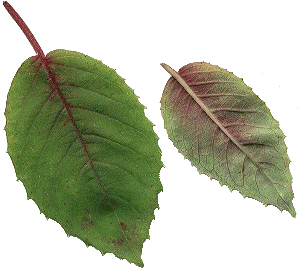
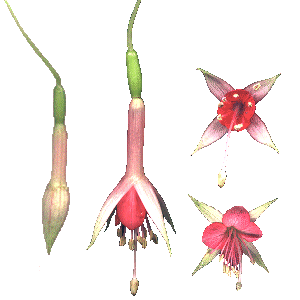

Daisy Bell - ?/Miescke 1962/1977? USA H E L.oranjeroze oranjeroze / T S l.orangepink orangepink
Ouders onbekend / Parentage unknown
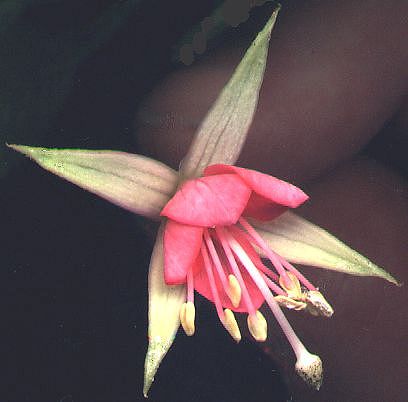
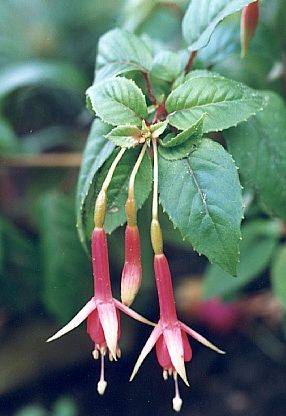
|
Hierboven een scan (4 x vergroot) en een bloeitakje met bloemen die levendiger van kleur zijn dan die helemaal bovenaan de bladzijde.
Beide kleurstellingen komen voor, de lichtomstandigheden zijn waarschijnlijk de oorzaak. Hetzelfde komt men tegen bij de beroemde 'Checkerboard', die een rode bloembuis, witte kelkbladen en een rode kroon behoort te hebben - ook daar laat de buiskleur het weleens afweten en blijkt dan bleekrose of wit. |
Above a scan (4 x enlarged), and a small branch with flowers that have more vivid colours than the one at the very top of this page.
Both colourings are common, probably light-circumstances are responsible. The same thing is found with the famous 'Checkerboard', which should have a red tube, white sepals and a red corolla - you also see it with a pale-pink or even white tube sometimes. |


|
Hoewel deze plant niet als een triphylla-type te boek staat, doet hij mij er wel enigszins aan denken, met de trossen
langwerpige bloemen aan de tak-einden. Van de afkomst is niets bekend, zelfs het jaartal en de kweker zijn twijfelachtig (zie boven). Het is een sterke plant, als hij eenmaal een winter is doorgekomen is hij vrijwel "onsterfelijk" mits hij niet bevriest. Inkuilen gaat probleemloos, en is de beste methode - de plant is geneigd tot roest in zulke jaren en is daar na inkuilen weer af het volgende seizoen. Een krachtige, warrige groeier die in tegenstelling tot de meeste fuchsia's makkelijk te scheuren valt. |
Although this plant is not called a triphylla in the cultivarlist, it's very much like one with these bunches of
long flowers at the ends of its branches. Its parents are unknown, even the year of its "making" and the grower are uncertain (see above). It's a strong plant, once it has come through one winter it's nearly "immortal" (but not winterhardy). A wintersleep under peatlitter gives no problems, and is to be recommended - this plant has a strong inclination to rust in "those" years, which has disappeared after the wintersleep, so it can have a clean start the next season. A powerful, knotty grower which can be divided into several plants, this being hardly possible with most other fuchsias. |
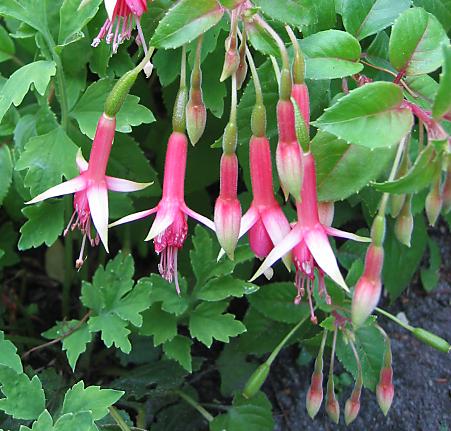
|
'Daisy Bell' staat als hanger in de cultivar-inventaris, maar kan evengoed als een slappe struik worden gekweekt. Ik heb er een stuk of 10 (ze vallen soms bij het rooien in de herfst in twee stukken uiteen), ik zet ze gewoon in de volle grond. Het ene jaar is de bloei veel rijker dan het andere, het lichtgroene rood-generfde blad heeft wel licht nodig maar houdt niet van felle zon, dan kleurt het meestal rood en de plant bloeit niet. De afgelopen (natte) zomer 2002 waren er goede bloeiresultaten, zoals op de foto hierboven. |
'Daisy Bell' is called a trailer in the cultivar-list, but all the same can be grown as a bush, though it won't grow very upright. I have about 10 of these, they sometimes fall apart in two pieces when uprooted in the autumn. I just plant them in the open ground. One year they bloom better than the other, the red-nerved light-green foliage needs light but doesn't like hot sunshine, which makes it turn red and the plant doesn't flower. Last summer, wet 2002, blooming results were good, as shown in the picture above. |


